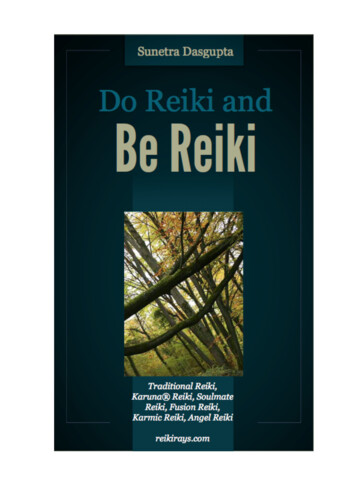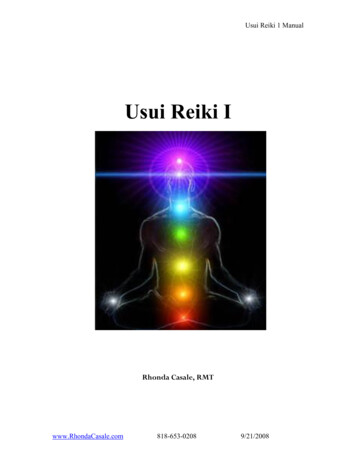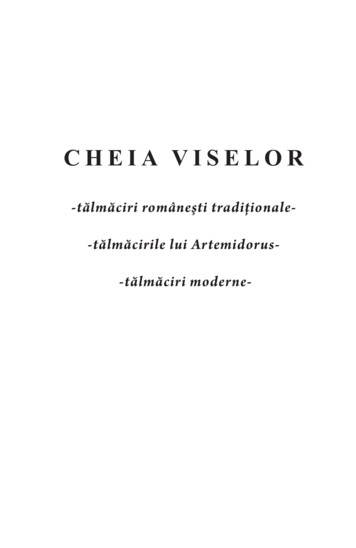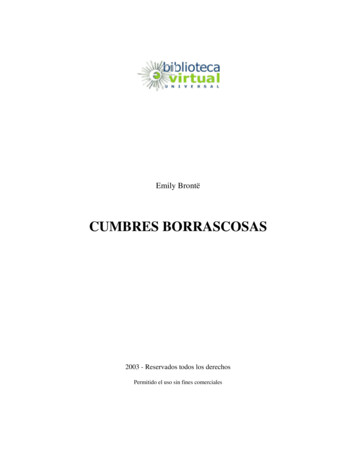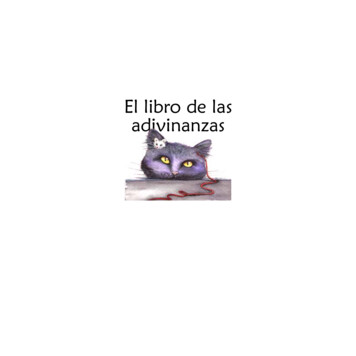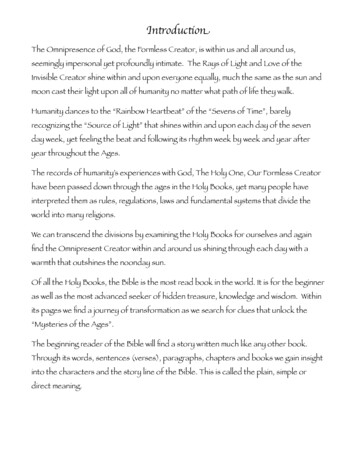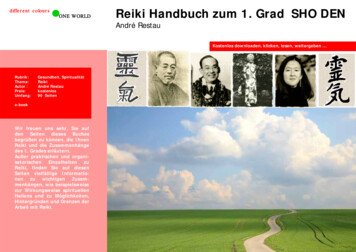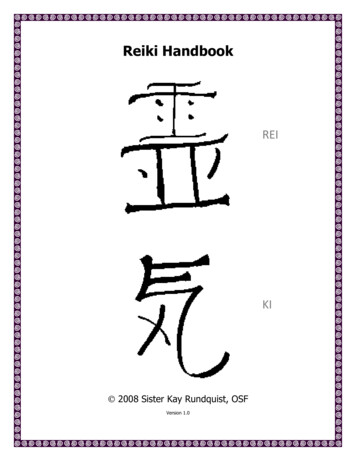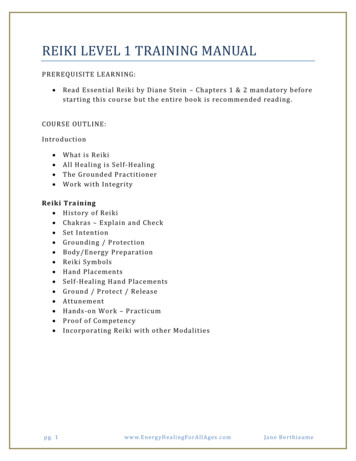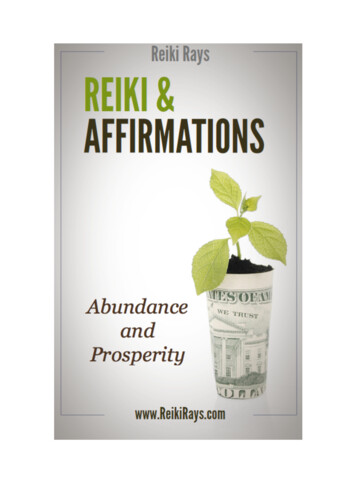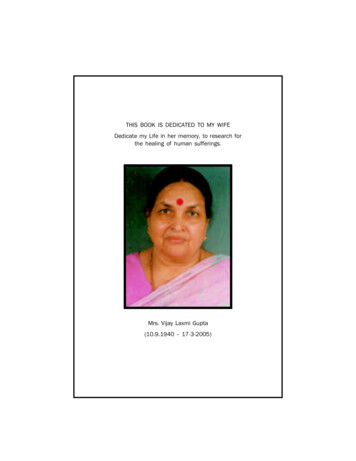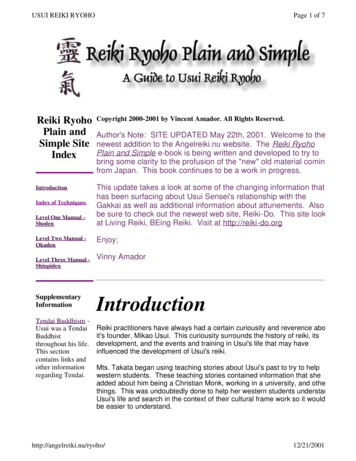
Transcription
USUI REIKI RYOHOPage 1 of 7Reiki RyohoPlain andSimple SiteIndexCopyright 2000-2001 by Vincent Amador. All Rights Reserved.IntroductionThis update takes a look at some of the changing information thathas been surfacing about Usui Sensei's relationship with theGakkai as well as additional information about attunements. Alsobe sure to check out the newest web site, Reiki-Do. This site looksat Living Reiki, BEing Reiki. Visit at http://reiki-do.orgIndex of TechniquesLevel One Manual ShodenLevel Two Manual OkudenLevel Three Manual ShinpidenSupplementaryInformationTendai Buddhism Usui was a TendaiBuddhistthroughout his life.This sectioncontains links andother informationregarding Tendai.Author's Note: SITE UPDATED May 22th, 2001. Welcome to thenewest addition to the Angelreiki.nu website. The Reiki RyohoPlain and Simple e-book is being written and developed to try tobring some clarity to the profusion of the "new" old material comingfrom Japan. This book continues to be a work in progress.Enjoy;Vinny AmadorIntroductionReiki practitioners have always had a certain curiousity and reverence aboutit's founder, Mikao Usui. This curiousity surrounds the history of reiki, itsdevelopment, and the events and training in Usui's life that may haveinfluenced the development of Usui's reiki.Mts. Takata began using teaching stories about Usui's past to try to helpwestern students. These teaching stories contained information that sheadded about him being a Christian Monk, working in a university, and otherthings. This was undoubtedly done to help her western students understandUsui's life and search in the context of their cultural frame work so it wouldbe easier to understand.http://angelreiki.nu/ryoho/12/21/2001
USUI REIKI RYOHOPage 2 of 7Unfortunately many began to codify these teaching stories as dogmafollowing the death of Mrs. Takata. Some stories began to take on a life oftheir own, such as the story of the beggars being used to justify "energyexchanges". Many began to lose the connection to the points that Mrs.Takata was trying to make with her teaching stories. This was the "reikihistory" as it was known in the west.The history was the history, until it was no longer the history.Many began to channel wild theories regarding this and soon reiki waschanneled to be from Tibet, Atlantis, Egypt or Lemuria. It's 'original"founders were said to be "ascended masters", "galactic brotherhood's", anancient Chinese named "Wei Chi", and many others. (author's note: myfavorite theory involved the space aliens, I always love those,especially the X-Files.) While these channelings were interesting, theylacked any historical evidence that might lead someone to take themseriously.It was commonly taught in the US that Hayashi Sensei was Usui's star pupilwho received the mantle of Reiki. It was also commonly thought that thelineage was passed to Mrs. Takata. Because of this there was nomovement to explore reiki in Japan. It was not until quite recently that thisbegan to occur. The people exploring reiki in Japan began to uncover anumber of interesting things. Unlike the western practices of Mrs. Takata,reiki was not an "oral tradition" in Japan. Usui and Hayashi both had writtenmanuals that they gave students and there were handwritten notes ofsymbols and practices that students had been given that survived to thisday. There were historical "facts" that began to emerge such as Usui wasnot a Christian Monk, he did not teach at Doshisha University, he did notrequire payments or exchanges and on and on. What initially was astartling finding was that there was an organization that remained in anunbroken line from Usui. This was called the Usui Reiki Ryoho Gakkai.While this was a boon to find an organization that claimed to have the directlineage from Usui, the Gakkai is a tight and closed society of members anddo not freely share information regarding their art.One of the first pioneers to look back to Japan to try to see if there wasevidence remaining of reiki's past that survived Usui was Frank ArjavaPetter. He found Usui's memorial stone with a lengthy description of his lifeand virtue. He began to track down leads of surviving traditions in Japan.Much of Petter's findings are written in his books. Recently Petter wastouring the United States teaching the new history and other techniques thathe discovered being practiced in Japan. Petter released much of thisinformation in his first book, "Reiki Fire".Petter found that there were several remaining lineages in Japan. In thewest, it was thought and taught by the Reiki Alliance that Takata was "Grandmaster" of reiki and that reiki was no longer taught in Japan. Both theseassertions proved incorrect. He discovered that Usui had made a number ofhttp://angelreiki.nu/ryoho/12/21/2001
USUI REIKI RYOHOPage 3 of 7masters besides Chujiro Hayashi. Some of these were Eguchi, Taketomi,and Gyuda (also known as Ushida). These masters, like Hayashi, hadtaught students and made a number of masters each. Additionally, Hayashihad made 13 or more masters, and several of them were still living,including master Tatsumi. There was not one reiki school in Japan, therewere many. There was not one history of reiki in Japan, there were many ofthem. There was not one set of "true reiki techniques", there were severalstyles. It is important to keep this in mind in evaluating the importation ofthese techniques.Another person that explored reiki in Japan was Dave King. Mr. Kingreceived his material from a living surviving Hayashi Master whose namewas Tatsumi. This material was put together and called "TraditionalJapanese Reiki", and more recently "Usui-Do". Initially, those that receivedthis material were quite reluctant to share any of it and they continue to bethis way.Starting about 1998, a new stream of information began to trickle fromvarious other individuals who were researching this in Japan. Frank Petterreleased a second, and then third, book about the subject. Several westernmasters made the acquaintance of a man practicing in Japan named HiroshiDoi. Doi was brought over in September 1999 and taught a seminar onReiki Reiho based supposedly on the teachings of the Gakkai.This "new" material from these Japanese sources has been lumpedtogether under the name "Reiki Ryoho", "Usui Reiki Ryoho", or just plain"Reiho". Some new schools have started calling themselves Usui ReikiRyoho International" or "URRI". In the west, the vast majority of lineagesand teachings come from Hawayo Takata, who was a master and studiedunder Hayashi in the early 1930's. She called her Reiki, "Usui Shiki Ryoho",or Usui System of Natural Healing. Tatsumi, another of Hayashi's masterscalled his reiki, "Hayashi Reiki Ryouhou Kenkyu-kai", or Hayashi ReikiResearch Society. It needs to be noted that Hayashi continued to developreiki in Japan in his organization and he taught others after Takata. It shouldbe no surprise therefore that there are surviving lines of reiki in Japan, andlines that differ from one another. However it should also be no surprise thatthey are more alike that different and different from reiki as it evolved in thewest. There are surviving Hayashi lineages from Hayashi, and from theMasters that he made during the course of his teaching.This Reiki Ryoho material is mostly from the Petter and Hiroshi Doi sources.Petter is originally a western Hayashi lineage master that began teachingreiki in Japan. Doi Sensei was a western trained reiki master that alsostudied with masters in Japan. It needs to be noted that despite DoiSensei's impeccable credentials, he is only Okuden (level II) in the Gakkai,not a master. He has never been taught the secret teachings. (There arethree levels, Shoden, Okuden, and Shinpiden (master or secret level). Doitrained with western masters and then went to japan and trained withmasters in some of the surviving Japanese lineages. It is said that he alsohttp://angelreiki.nu/ryoho/12/21/2001
USUI REIKI RYOHOPage 4 of 7trained personally with Kimiko Koyoma Sensei who was the 6th president ofthe Usui Reiki Ryoho Gakkai. His style that he teaches in Japan is called"Gendai Reiki", or "Modern Reiki Method".These techniques were greeted with a great enthusiasm by some, and agreat skepticism by others. The enthusiastic beamed that we had foundUsui's original art and the "lost" techniques. The skeptics tended to focus ona number of significant issues. First, Japanese society has a far greateremphasis on tradition, and clubs and societies in Japan tend to closely keeptheir information among their members. The Gakkai and these otherorganizations have existed for years with indifference to the westernpractices, so why would they suddenly decided to reverse course and openup. Second, the Gakkai itself has disclosed nothing. Most of the purportedGakkai material comes from a level II student there (he is a master in thewestern tradition), not one initiated in the Shinpiden or secret teachings.Additionally, there is no one reiki in Japan. Some of the schools havedifferent information that is hard to reconcile and indeed little has seemed tocome directly from any of them, but rather through a number ofintermediaries. This is not to say that these were not original Usuitechniques, but rather that it is impossible to tell. Perhaps one day some ofthese individuals and organizations that claim to have Usui's original noteswill deign to release them to the rest of the reiki world and then we shallknow with certainty. Until that time, these should be regarded as interestingtechniques that represent the evolution of Reiki in the various Japaneselineages. Try not to focus on this in terms of correct, original, or right, butinstead as a parallel system to the Hayashi-Takata evolution that came tothe west.Additionally, understand that while some might consider these techniquesand practices to be a welcome addition, they are not necessary to practicereiki. A parallel from the martial arts might help explain this. Karate is amartial art that was practiced in Okinawa. Originally, the kanji for karate wastwo separate kanji; kara and te. "Kara" meant "China" and "te" meant hand.The art originally came from Chinese Kung Fu. Over time, the kanji weresaid to mean "empty hand", rather than "china hand". The art evolved.Large flowery movements became streamlined, linear and more direct. Itwas adapted by the masters to fit the needs of the Okinawans. The art wastaught to Gichin Funakoshi, a Japanese man, who brought the art to Japan.These days there are many styles of Karate. Each represents an evolution,and an adaptation for the people who received it. There is no better style,just different ones. Hayashi made changes to reiki from Usui's model. TheGakkai made changes from Usui's model. Many of the other masters madechanges as they saw fit for the benefit of their students. Hayashi taughtTakata, who made changes necessary to make reiki understood forAmericans. Reiki has flourished in America. Her art was streamlined andflowed smoothly, and is the legacy we have today. As Karate is no longerChinese Kung Fu, perhaps Takata's gift is no longer exactly the samepractices that have evolved in Japan, and yet we are all brothers and sistersof Usui's gift. Share it, enjoy it, be with it. If you find any of these from thehttp://angelreiki.nu/ryoho/12/21/2001
USUI REIKI RYOHOPage 5 of 7Japanese line of benefit, then use them. If not, be grateful for the gift of reikithat we have.As The Reiki Ryoho information came out, it has been confusing to get acomprehensive grasp on it. This is compounded due to the material comingfrom several sources, and often there are multiple names for thetechniques. This is made more difficult due to the problems mostwesterners have with understanding Japanese. To make it even still moreconfusing some have been mixing in some of the Hayashi material that didnot continue on in Takata's practices. If you were not confused enough, stillothers have been adding in Hiroshi Doi's Gendai Reiki practices as well.Finally, there is information coming out now that Usui may not have foundedthe Gakkai. There is only evidence that he started a clinic and school. TheGakkai appears to have been founded by his top masters. Because of this itis unclear which of these techniques that appear in this manual were reallyhis original practices. It appears certain that he taught the five handpositions listed herein, byosen and reiji, hatsurei ho, and empoweredstudents with reiju. Other than that the rest is anyone's guess. Most of thetechniques listed in this manual are common to many forms of chi gung(KiKo in Japanese).In the spirit of it's sister publication " Reiki Plain and Simple - AComprehensive Guide to Usui Shiki Ryoho", this e-book "Reiki RyohoPlain and Simple - A Compendium of Reiki Ryoho Techniques" is anattempt to integrate, cohesively organize, and simplify the Ryoho materialthat is now proliferating. What follows in this manual is representative ofareas of concurrence from the many sources that I have. When disparatesources are reporting the same techniques it is likely that they were from acommon source, namely Usui's original practices. Differences in techniquesin the various sources of information may indicate that these are techniquesadded later, or ones that are specific to that lineage.Last, the issue of "what to make of all this" needs to be addressed. Whenthis material originally came out I was greatly excited. I remember thinking"now we will finally know what Usui's original art was like". As I began toexplore this further I began to wonder what this meant in regards to the UsuiShiki Ryoho that we had learned here in the west. It began to dawn on meslowly that it meant nothing at all.Recently I was having a discussion about the "new" old reiki ryoho materialwith three reiki pals. One of them was holding the position that Takata's UsuiShiki Ryoho was complete in and of itself and that while the ryoho materialwas nice it was not
The Reiki Ryoho Plain and Simple e-book is being written and developed to try to bring some clarity to the profusion of the "new" old material coming from Japan. This book continues to be a work in progress. This update takes a look at some of the changing information that has been surfacing about Usui Sensei's relationship with the Gakkai as well as additional information about attunements .
